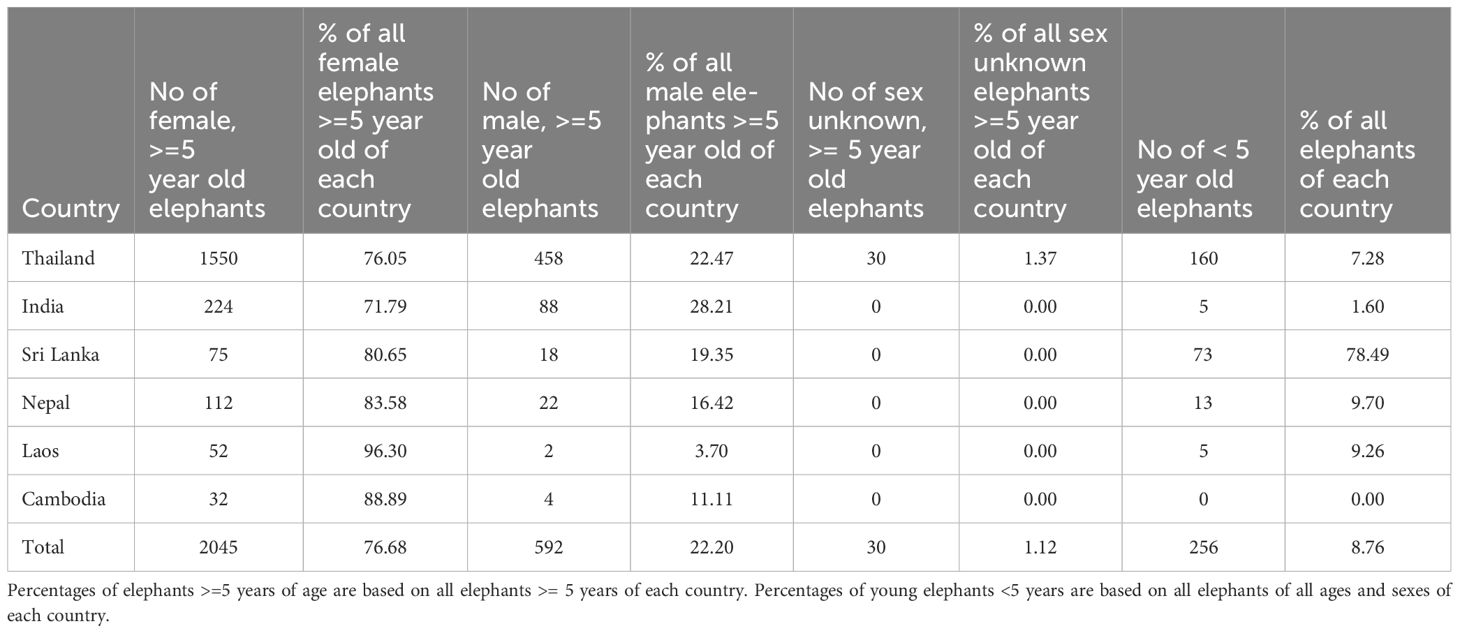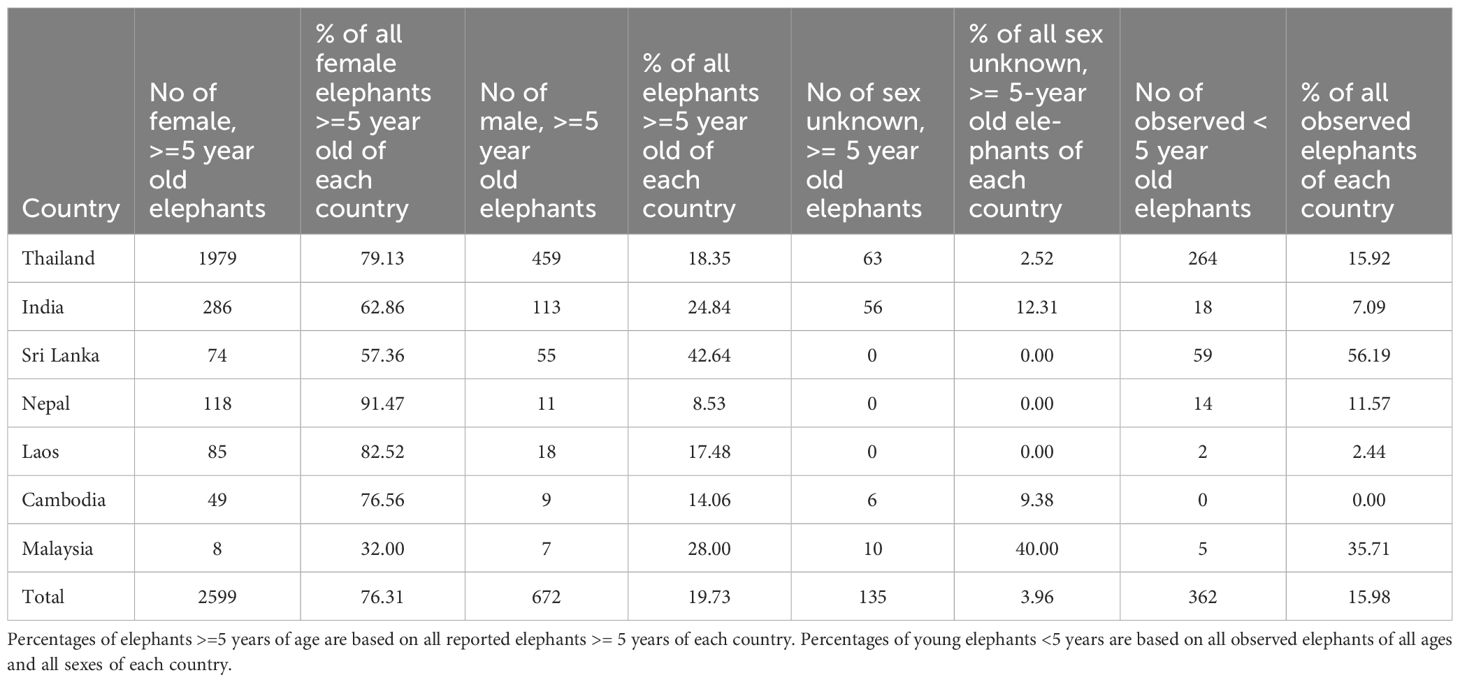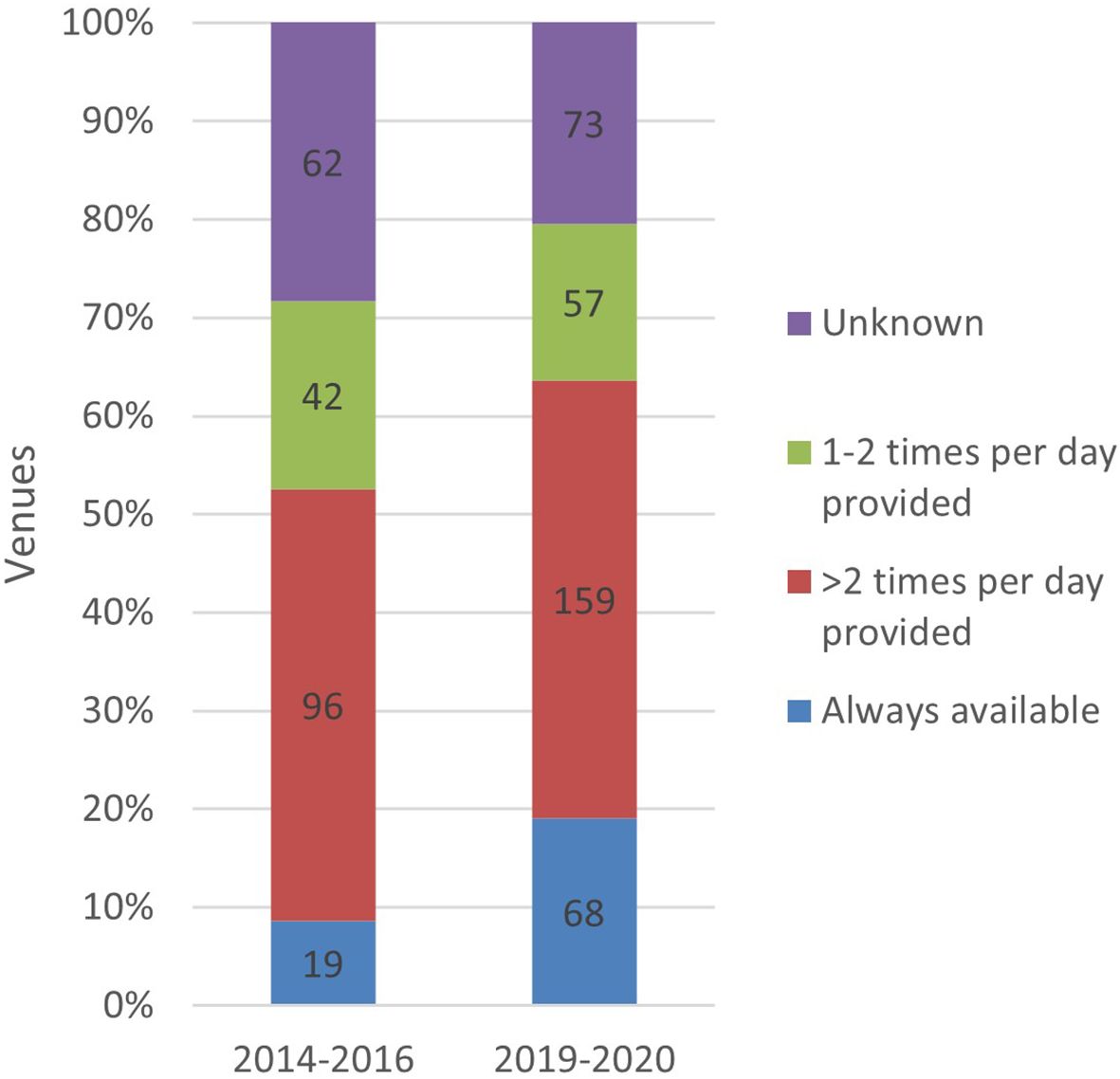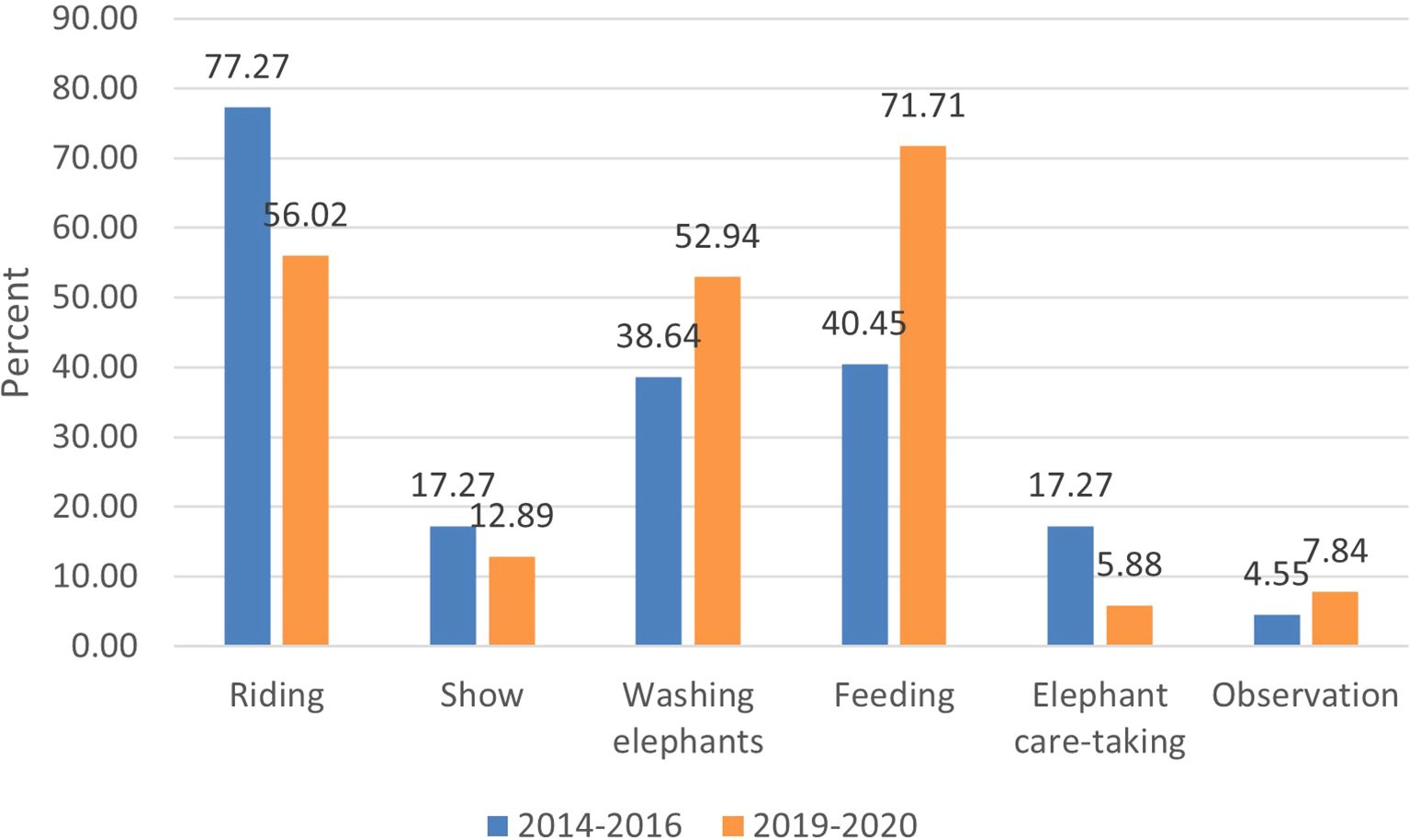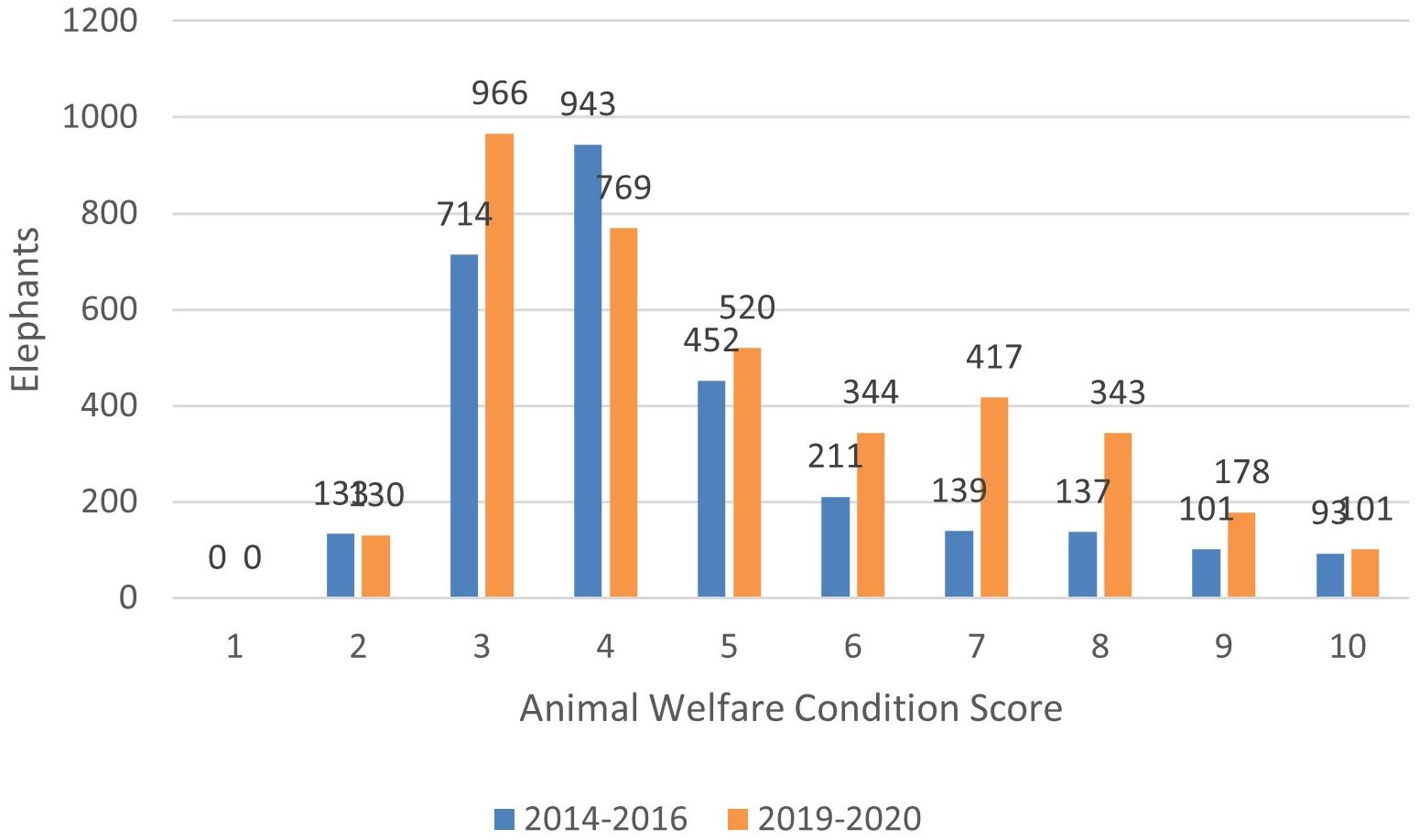- World Animal Protection, London, United Kingdom
Asian elephants (Elephas maximus) are kept at commercial facilities as tourist attractions across many of their range states. Maintaining elephants in captivity presents a multitude of challenges for meeting their physical and behavioral needs as a wild species. Significant cause for concern for the welfare of elephants at tourism venues has previously been published and includes the need for severe restraint, limitations to nutritional variety, stressful interactions with visitors, and harmful practices of controlling the elephants, to name a few. This study presents data from the longest and most comprehensive assessment of captive conditions for Asian elephants in the tourism industry, to date. Researchers visited elephant tourism venues across Thailand, India, Laos, Cambodia, Nepal, Sri Lanka and Malaysia in 2014–2016 and 2019-2020. These were continuations of an earlier study in Thailand from 2009-2010, which allows a ten-year perspective. The most recent assessments documented 3,837 elephants kept at 357 tourism venues across these countries. Here we define trends observed across the industry in the period 2010–2019 and discuss the welfare concerns associated with the captive conditions documented during the study period. Our data indicate that while during the duration of the study animal welfare condition scores improved across almost all assessed welfare condition indicators, they remained low for the majority of elephants. There was a notable decrease in the frequency of venues offering elephant rides but a significant increase in other tourist experiences that allow direct visitor interaction with elephants, such as elephant washing and feeding. Despite fluctuating trends and some improvements in management, over 3,000 elephants still faced challenges to their welfare in 2020. Documented improvements to elephant tourism venues indicate a diversification of tourism experiences to cater to an emerging demand for ethical tourism activities, yet not an actual phase out of problematic practices. We hope our data can provide a snapshot of the conditions provided for the majority of captive Asian elephants, on a wide scale and over an extended time period, to provide a broad perspective of welfare within the captive elephant tourism industry as a whole.
1 Introduction
The Asian elephant (Elephas maximus) is one of the largest living terrestrial vertebrates (Kido et al., 2020), occupying 13 range states across Asia with a current population estimated between 45,671 and 49,028 elephants (Sakamoto, 2017; IUCN Asian Elephant Specialist Group, 2018). There are three commonly recognized sub-species: the Indian elephant (Elephas maximus indicus) on the Asian mainland; the Ceylon elephant (E. m. maximus) in Sri Lanka, and the Sumatran elephant (E. m. sumatranus) in Indonesia (IUCN Asian Elephant Specialist Group, 2018). Asian elephants are an endangered species and occupy only about six percent of their historic range (Sukumar, 2003; Keerthipriya and Vidya, 2019), with approximately 15,000 of the remaining individuals held in captivity (Sakamoto, 2017; Bansiddhi et al., 2018). They are listed on Appendix I of the Convention of International Trade in Endangered Species (CITES), which regulates international trade of elephants and their body parts.
Asian elephants have been depicted working for humans since 2000 BC (Roots, 2007) for purposes ranging from draught work (e.g. logging) to wars (e.g. for combat and transport) and in temples (e.g. as idol bearers) (Sukumar, 2003; Vijayakrishnan and Sinha, 2019). In recent decades, due to the increase in demand for animal-related tourism and a decrease in demand in other traditional elephant work environments, a growing number of elephants have been kept at tourism facilities as entertainment attractions to touch, photograph and ride, or to perform in shows, displaying tasks such as tightrope walking, football and basketball playing, painting, or tricycle riding (Worwag et al., 2019). Some facilities also offer ‘be a mahout for a day’ experiences where tourists pay to mimic tasks undertaken by mahouts (elephant handlers), and to feed and bathe the elephants in semi-natural captive settings.
In 2015 there was an estimated 2,923 captive elephants used for tourist purposes across Asia, the majority of which were in Thailand (Schmidt-Burbach, 2017). The number of elephant tourism facilities throughout Thailand rose steeply following a nationwide logging ban in 1989, which resulted in thousands of elephants and their mahouts suddenly becoming unemployed and seeking alternative forms of income (Bansiddhi et al., 2018). Myanmar is currently phasing out their national logging industry, thus their captive elephant population may soon be out of work and follow in similar suite to Thailand’s elephants just a few decades ago (Jaysinghe and Soe, 2017; Bansiddhi et al., 2018).
Despite a long history of being maintained in captivity, Asian elephants in human care are not domesticated – wherein domestication is defined as a long-term biological process that requires the maintenance of wild animals in captivity for many generations and causes significant, permanent changes in the behavior, physical attributes and genetics of the captive held species (Alves, 2016). They have never undergone systematic, multi-generation selection by humans for specific physical or behavioral traits (Kurt and Mar, 2003; Roots, 2007). Maintaining wild animals, such as elephants, in captivity presents a multitude of challenges for providing a suitable environment to meet their physical and behavioral needs as a wild species. Data shows that many aspects of captive living can affect an elephant’s biology, for example type and amount of work activities by elephants, amount of food offered by tourists, or visitor numbers to a facility can have an impact on body condition, adrenal activity, metabolic markers, and lipid profiles (Norkaew et al., 2019). An expert-led review of one hundred studies on captive conditions highlights that the physical and social conditions found in captive environments results in compromised welfare with long lasting detrimental psychological and physical effects (Elephant Specialist Alliance International, 2021). Providing a suitable captive environment is particularly challenging for long-lived, highly sentient species such as elephants, who have complex social structures that are difficult to artificially mimic in captivity and a wide range of individual variation in responses to environmental conditions (Mumby, 2019). Some experts believe that captive facilities can’t fulfil the biological, social, spatial, cognitive and intrinsic requirements of this complex species (Elephant Specialist Alliance International, 2021).
Previous studies have highlighted there is significant cause for concern for the welfare of elephants at tourism venues (Schmidt-Burbach et al., 2015; Baker and Winkler, 2020; Nokkaew et al., 2022; Szydlowski, 2022). Physical injuries caused by restraint equipment and saddles, foot and nail problems caused by increased time spent standing and walking on hard or rough substrates, and a lack of access to proper health care have all been reported in the literature (Bansiddhi et al., 2018). In addition, psychological assessments have shown stereotypic behaviors associated with chaining (the most practical and common method of restraining elephants when not working) (Bansiddhi et al., 2018) and data indicate a high proportion of Thailand’s captive elephant population, most of which are used for tourism, suffer from complex PTSD (Rizzolo and Bradshaw, 2018), with similar concerns reported in Sri Lanka (Rizzolo and Bradshaw, 2016).
In conjunction with these ongoing welfare concerns, the Covid-19 pandemic presented its own unique set of unforeseen challenges. With tourism at a stand-still the maintenance of thousands of elephants was jeopardized, showcasing the vulnerability and dependency of captive elephants reliant on tourism and highlighting the paradoxical dilemma faced by the industry: the need to sustain income to care for captive elephants, while perpetuating the principal cause for the need to resource care in the first place.
There have been significant changes in captive elephant management (particularly in Thailand) over the past 15 years, including less reliance on extensive chaining, decreasing use of saddles for riding, an increase in observation-only activities, and less reliance on hooks to train and control elephants (Bansiddhi et al., 2020). However, elephant management and care still varies considerably. Because there are few enforced guidelines or standards for elephant camps to follow (e.g. the only current laws in Thailand pertaining to elephant welfare are vaguely defined, have negligible maximum fines (Bansiddhi et al., 2018), or are not enforceable as there is no penalty for non-compliance (Bansiddhi et al., 2020)), facilities only address very basic requirements and beyond those manage elephants as per their preference, skillset or financial limitations. As a result elephant welfare is often negatively impacted (Schmidt-Burbach et al., 2015; Bansiddhi et al., 2018; Schmidt-Burbach and Hartley-Backhouse, 2020). Protection for elephants is still lagging behind in both policy and practice, and the industry is largely driven by the economic benefits of tourism experiences (Worwag et al., 2019).
It is not only the welfare of the elephants at tourist venues that is cause for concern, but the potential negative impact of the industry on the conservation of these species in the wild (Schmidt-Burbach et al., 2015). The main causes of Asian elephant population declines historically have been habitat loss and forest fragmentation, but poaching and illegal trade are now a significant regional concern (Nijman, 2014; Bansiddhi et al., 2020). Highly lucrative commercial tourism has created price tags ranging up to US$50,000 for one elephant (Nijman, 2014; Schmidt-Burbach et al., 2015), creating a dangerous incentive to poach wild elephants or to trade them illegally within countries and across national borders (Hankinson and Nijman, 2020).
Although the international trade of elephants for commerce has been illegal for decades (E. maximus are considered endangered by the International Union for Conservation of Nature (IUCN) and listed on Appendix I of the Convention on International Trade in Endangered Species (CITES)), investigations have demonstrated that Thailand is a main destination for illegally captured elephants from Myanmar (Nijman, 2014), and media articles as recently as 2018 report elephants exported illegally from Laos to China for the tourist industry (Dalton, 2018; Cruise, 2017). A lack of comprehensive record systems or studbooks to document the demographic history of the captive elephant population makes it difficult to ascertain how many Asian elephants in tourism have been captured directly from the wild (Bansiddhi et al., 2020).
The elephant tourism industry has become a topic of intense debate among tourists, scientists, animal welfare groups and stakeholders on a global level (Bansiddhi et al., 2018). A growing body of literature is recognizing the need for more objective indices to be validated and applied to assessing welfare of elephants under human care in Asia (Bansiddhi et al., 2020). Most research attention thus far has focused on parameters such as body condition, health status or glucocorticoid hormone levels (Bansiddhi et al., 2019a; Bansiddhi et al., 2019b) (although it should be noted there are many limitations to using cortisol measurements as a marker of welfare if used in isolation from other welfare indicators) (Millspaugh and Washburn, 2004; Palme, 2019)). These are all direct welfare measures that focus on assessment parameters in individuals for relatively short periods of their life. Currently missing from the literature is a thorough assessment of welfare conditions provided for the majority of elephants, on a wide scale over an extended time period, to provide a broader perspective of welfare within the industry as a whole. This broader perspective can be used to critically examine whether captivity in principle is able to meet the needs of elephants as a species, adding a critical lens to the literature which has thus far focused on improving quality of care across captive facilities but has largely neglected questioning the existence of the captive elephant industry in its entirety.
This study presents data from the longest and most comprehensive assessment of welfare conditions for Asian elephants in tourism, to date. From November 2014 – May 2016, and again from January 2019 to January 2020, the authors evaluated 3,837 elephants at 357 venues across India, Laos, Cambodia, Nepal, Sri Lanka and Malaysia, concluding a longitudinal study monitoring welfare conditions for tourism elephants in Thailand over a 10-year period and across the other countries over 5 years. Here we define trends and quantify concerns in the captive elephant tourism industry with data comprised from assessments of as close as possible to 100% of the existing captive elephant tourism venues. The assessments included facilities offering any tourism experiences with captive elephants, such as elephant riding, performances, caretaking, feeding or observation. We provide a novel perspective on the elephant tourism industry in Asia drawing on data with a wide scope and scale.
2 Methods
Captive elephant tourism venues across Thailand, India, Laos, Cambodia, Nepal, Sri Lanka and Malaysia, were visited by researchers between 2014–2016 and again between 2019 - 2020. Previously published results from the same assessment conducted between 2009–2010 in Thailand will be used in the discussion part of this study for longitudinal trend analysis in comparison with the more recent data of the last two data collection periods (Schmidt-Burbach et al., 2015).
Venues were identified through a review of internet adverts, guidebooks, tourism leaflets, conversations with travel agents at kiosks in each local area, and physical scouting of popular tourism destinations known to have elephant attractions. The GPS locations of venues visited in earlier assessment rounds were also used as reference points for subsequent visits. The assessment focused on elephants in venues destined for tourism; it does not reflect the entire captive elephant population (for example, elephants kept in zoos, circuses, sanctuaries, or logging camps).
Researchers visited venues as tourists and recorded observational data in a pre-established data sheet (Appendix 1). Venues were not made aware of these visits beforehand to ensure documenting actual conditions. A total of 10 researchers conducted venue visits across the study period. Prior to visiting venues, researchers received training to ensure consistent data collection and scoring across all individuals. Each researcher also conducted several test assessments using virtual models of 10 fictional elephant venues, and inter-observer reliability was validated using Crombach Alpha test (α=0.79).
During the 2014–2016 field work, a total of 230 elephant tourism venues were identified across the countries included in the study, and 220 venues were visited in person by a researcher at least once for data collection. During the second round of field work from 2019-2020, a total of 367 elephant tourism venues were identified across the countries included in the study. Of these, 357 were visited in person by a researcher at least once for data collection. For the remaining venues, visits were not possible due to either logistical challenges or lacking invitations where such an invitation was required. To maximize robustness and consistency, all data points presented in this manuscript are based on the visited venues only.
Information was collected via direct observations and through conversations with venue staff. Photographs and videos were captured to document observations. Environmental noise data was measured within 10m to the resting place of elephants, using the app ‘Sound Meter’ by Smart Tools in version 1.7.18. Behavior, such as stereotypies, was observed over at least five minutes and from at least 10 meters away to mitigate stress caused to the animals. Stereotypic behavior is defined as repetitive behavior that serves no specific purpose, such as pacing back and forth on the same path, swaying sideways, or head bobbing. The type of social interaction was distinguished between elephants being able to directly interact with 1 or with >1 elephants freely (not under restraint), elephants being able to interact directly with other elephants under restraint, and elephants being able to interact only through visual or auditory communication over a distance. Data was initially recorded manually on physical data sheets and subsequently transferred to digital format using Survey Monkey software. Analysis and descriptive statistics were conducted in Excel. Data recorded at venues related to aspects of physical venue conditions, interaction between elephants, animal handing and restraint practices, diet provisions, type and intensity of elephant entertainment offered, and elephant behavior and physical health condition. Demographic information such as the age and sex of elephants at the venue was also recorded by researchers. The full data sheet is available in Appendix 1.
We scored animal welfare conditions based on data and information gathered during visits to venues. The score sheet was comprised of nine criteria considered to have a significant impact on elephant’s living conditions, adapted from the well-established and validated WelfareQuality® assessment system often used for livestock. Each criterion was scored along a 5-point scale from 0–4 for each venue with the lowest score equaling poor conditions and the highest score representing best possible captive conditions (Supplementary Table 1). In order to convey the overall welfare conditions, those nine criteria scores were consolidated into a single score. For better reflection of nuances in the conditions, the chosen scale for the overall welfare conditions ranged from 1 to 10. For this, the sum of the nine scores from each criterion were divided by the maximum possible score, then multiplied by 9 and added 1 to convert to the 1 to 10 scale. Where rounding was required, scores of.0–.4 were rounded down, while scores of.5 –.9 were rounded up to the next digit (aligned with previously published methodology (Schmidt-Burbach et al., 2015; Carder et al., 2016)). Our study is limited to rapid assessments of overall conditions provided at elephant venues to inform a broad perspective on the living conditions and daily experiences of captive tourism elephants on a large scale across the industry. The limitations of our approach are discussed further below.
GIS visualization was conducted using QGIS v3.30.3. As base layer with country boundaries Natural Earth’s shapefile “Admin 0 – countries” was used. A grid with square cells of 0.25-degree side lengths was created for displaying the number of elephants at all venues within each cell, and the average animal welfare condition score for all venues within each cell.
3 Results
3.1 Industry summary
Our data show that in January 2020, 3,837 elephants were kept at 357 tourism venues across Thailand, India, Nepal, Sri Lanka, Laos, Cambodia and Malaysia. Over the two rounds of assessments, the total number of venues increased by 62% from 220 to 357 venues five years later. The majority of venues were located in Thailand (68.18% in 2014 and 68.91% in 2019, respectively), followed by Nepal (16.36% and 15.41%), India (5.45% and 5.88%), Sri Lanka (5.45% and 3.64%), Laos (2.73% and 3.08%), Cambodia (1.82% and 2.8%) and Malaysia (0.28%). The increase in venue numbers over those five years occurred proportionally across all countries.
A somewhat similar development was observed for the number of elephants across those tourism venues (Table 1). Over the five years of the two rounds of venue visits, the total number of elephants increased from 2,923 to 3,768 animals. During both assessments, Thailand’s venues housed by far the largest number of elephants (75.20% and 73.38%), followed by India (10.85% and 12.55%), Sri Lanka (5.68% and 4.99%), Nepal (5.03% and 3.8%), Laos (2.02% and 2.79%), Cambodia (1.23% and 1.70%) and Malaysia (0.80%).

Table 1. Elephant tourism venues and reported elephant numbers per country in 2014–2016 and 2019-2020, as well as each countries proportion of all venues/all elephants, and difference in those proportions between the two studies.
Table 1 details the number of elephants and tourism venues identified across all seven countries over the course of the study period.
The sex ratio of females to males among the adult and juvenile age group, for which a sex could be defined either through reports by staff or observation, was approximately 3.5:1 in 2014-2016 (2,045 females (76.68%), 592 males (22.20%), and 3.9:1 in 2019-2020 (2,599 females (76.31%), 672 males (19.73%) (Tables 2, 3).
Young elephants below the age of 5 years made up 15.98% of all observed tourism elephants in 2019-2020. In Thailand, housing the largest number of captive tourism elephants, 264 (15.92%) <5-year-old elephants were identified in 2019-2020.
In the 2014–2016 data collection, no distinction was made between elephants ‘observed’ in person and ‘reported’ by the venue. This is of relevance for interpreting the percentage of young elephants, as young elephants were primarily identified through observation and thus calculating the percentage of all ‘reported’ elephants may indicate a lower value than it should be.
3.2 Spatial distribution of elephant venues by country
Mapping the location of tourism elephant venues indicates distinct clusters (areas with elephant venues across more than one grid cell) within each country. In Thailand, in 2014–2016 these clusters are located in the greater Chiang Mai area, Bangkok, Kanchanaburi, Pattaya, Koh Samui and the greater Phuket/Phang Nga area (Figure 1A). Of these areas, Bangkok, Chiang Mai, Pattaya and Phuket all show at least one cell with >200 elephants, indicating a high density of tourism elephants. In Laos a cluster can be seen in the Luang Prabang area, but only with low to moderate elephant densities (Figure 1A). Cambodia in 2014–2016 had only one low density cluster near Mondulkiri (Figure 1A). Nepal shows only one cluster with moderate densities near Sauraha, Chitwan (Figure 1B). India’s venues did not show any cluster concentration. But a high-density cell near Jaipur and a medium-high cell north of Kochi indicate significant elephant tourism densities there (Figures 1B, C). Similarly, in Sri Lanka the venues are somewhat dispersed and only in the 2019–2020 map show a high-density cluster near Kandy (Figure 1C).
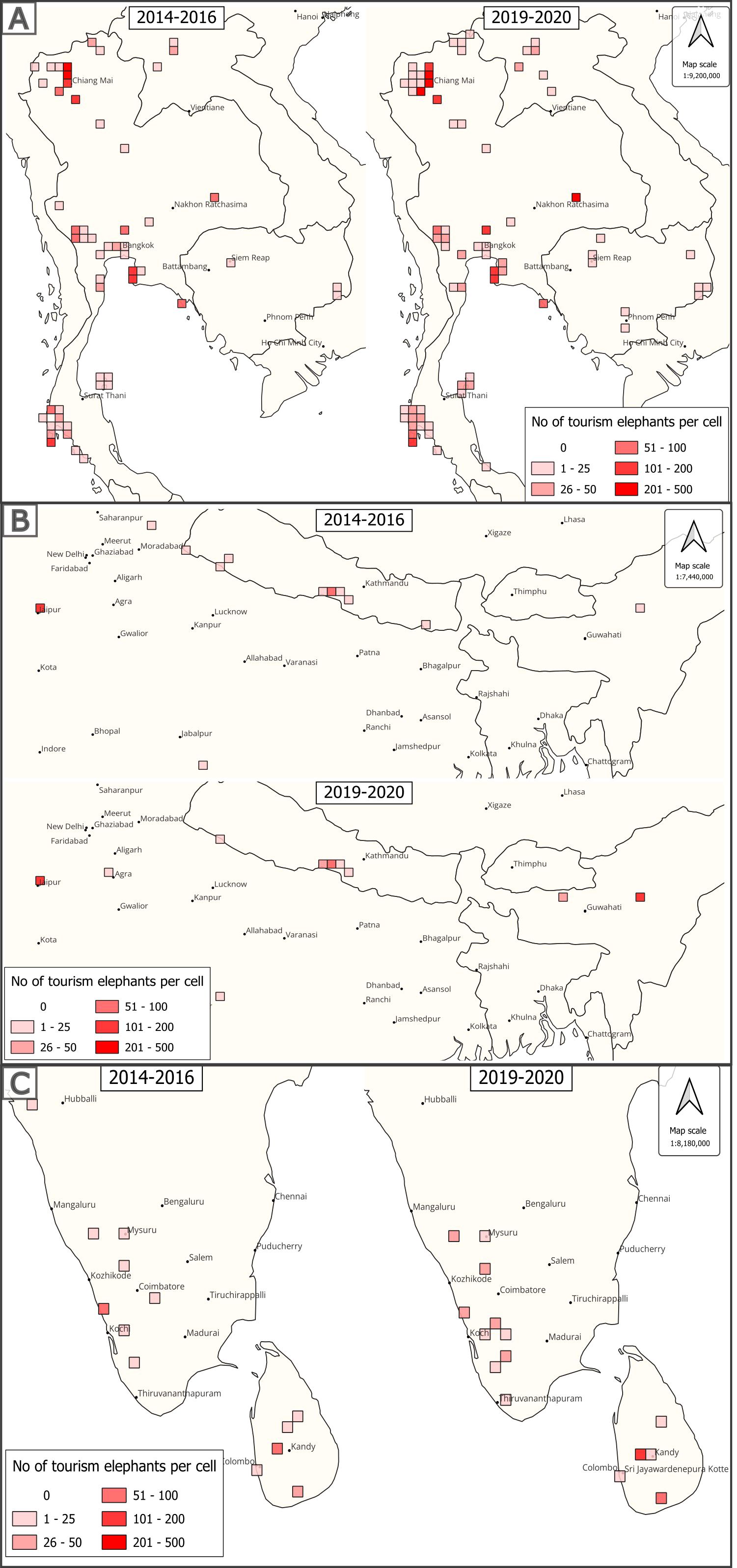
Figure 1. (A-C) Number of tourism elephants of all venues within a grid cell in 2014–2016 and 2019–2020 for Thailand, Laos and Cambodia (A), northern India and Nepal (B), and southern India and Sri Lanka (C).
Comparing the geographic spread of venues between 2014–2016 and 2019–2020 generally show a broadening of the spread of venues across additional cells, increasing the size of the previous clusters or forming new small clusters. Particularly in Thailand, a general increase in density of elephants per cell can be observed through a shift up by one gradient step as per map legend.
3.3 Venue conditions and animal husbandry
A range of husbandry related parameters were collected during each elephant venue visit. These parameters have an impact on the animal’s welfare as they typically govern the animal’s ability to exercise choice, engage with their environment, and their range of natural behavior.
When not used for tourism activities, basic elephant management standards govern that elephants will generally need to be restrained to prevent them from straying off and posing a threat to people or property. In this study, we only counted elephants actually observed during the day, excluding elephants absent or in use for tourism activities. More than half of the observed elephants were restrained using chains shorter than 3m in both data collection periods (2014-2016: 1,184 (65.41%) elephants (n=1,810); 2019-2020: 898 (53.26%) elephants (n=1,686); Supplementary Table 2). These restraints were used at 152 (62.81%) venues in 2014-2016 (n=242) and 192 (55.17%) in 2019-2020 (n=348, Supplementary Table 2, Figure 2). The next common restraint type was elephants free ranging under supervision of their mahout (2014-2016: 275 (15.19%) elephants; 2019-2020: 444 (26.33%) elephants). These methods were used at 30 (12.40%) venues in 2014–2016 and 76 (21.84%) venues in 2019-2020. It must be noted that this category was prone to a wide range of different elephant management styles, ranging from saddled elephants not kept on chains but prevented from walking away by their mahouts, to elephants living in natural forest habitat and only minimally controlled by their mahouts.
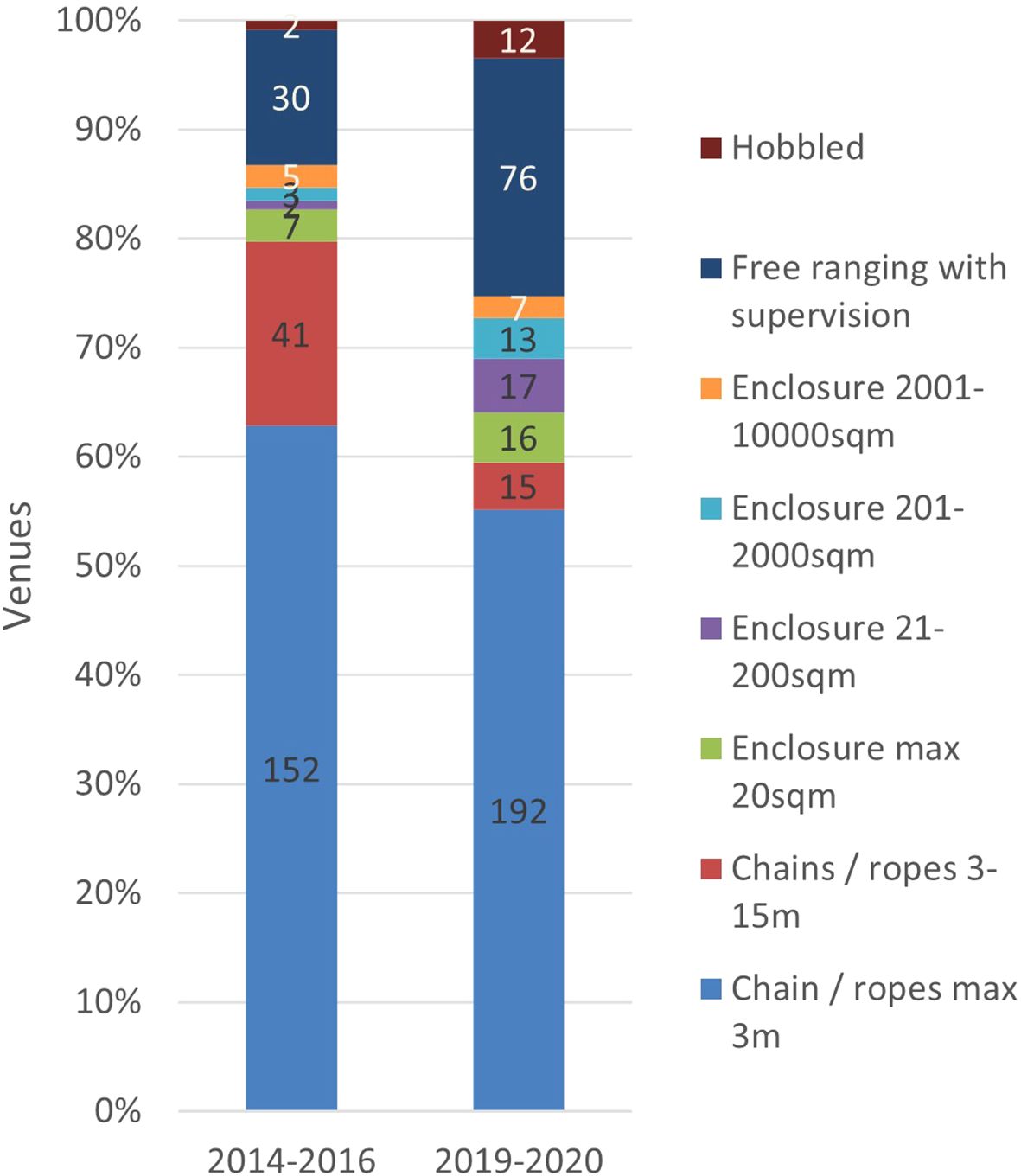
Figure 2. Types of observed restraining methods for elephants across venues in 2014–2016 and 2019-2020, per number and proportion of venues.
When used for tourism activities or otherwise under command by their mahouts, the by far most common method of control was the use of sharp or pointy tools, such as bull hooks/axes or spears (80%, n=176, 2014-2016; 60.78%, n=217, 2019-2020, Supplementary Table 3), followed by the use of blunt sticks (32.73%, n=72, 2014-2016; 25.77%, n=92, 2019-2020). Use of nails and nail sticks was only documented in less than 5% of venues, although this is often the most difficult to identify tool, as their use is hard to observe due to the small size of the nails.
In 2014–2016 almost half of all elephants (46.6%, n=1,165) were able to only interact non-tactile through visual and auditory communication, followed by 32,96% (n=824) that could have tactile interaction with another elephant while restraint (Figure 3, Supplementary Table 4). In 2019–2020 the proportion of both of those categories decreased in favor of a doubling of elephants benefitting from conditions that allowed them to interact freely with more than 1 other elephant (2014-2015 = 13.72% (n=343); 2019-2020 = 26.30% (n=728). Despite that trend, elephants being limited to only visual/auditory communication still made up the largest group in 2019-2020.
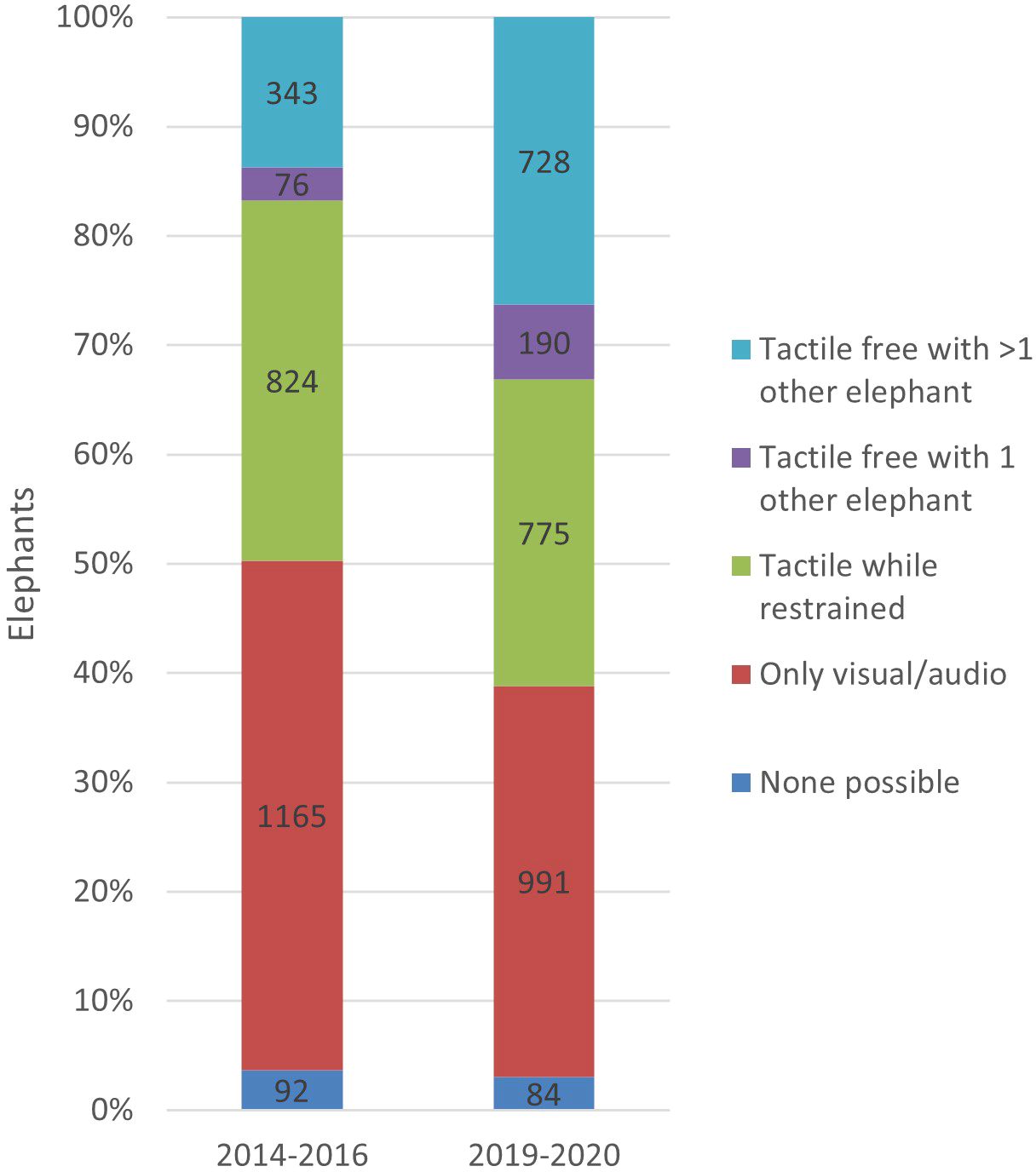
Figure 3. The quality of social interaction possible for elephants while not participating in tourism activities, per number and proportion of elephants.
Stereotypic behaviors were displayed by 15.14% of observed elephants (n=343, 2019-2020, Supplementary Table 4) during the visit time. In the 2014–2016 study period the number of stereotyping elephants was even higher (n=459) but as we did not distinguish between total numbers of elephants reported by the venue and the actual number observed by the researchers, we cannot determine the percentage for that time period.
The type of ground that the majority of elephants at a venue would be restrained on during the day was found to be grass/earth for 70,91% of venues, keeping 1,827 elephants (2014-2016, n=220) and 68.26% of venues, keeping 2,223 elephants in 2019-2020 (n=356, Supplementary Table 5, Figure 4). This was followed by concrete or tiled ground at 22% (2014-2016) and 17.42% (2019-2020) of venues, keeping 894 and 1057 elephants respectively. While the proportion of venues with grass/earth decreased slightly between those two periods, this was in favor of an increase of sand or stone/gravel material, and a decrease in concrete/tile substrate.
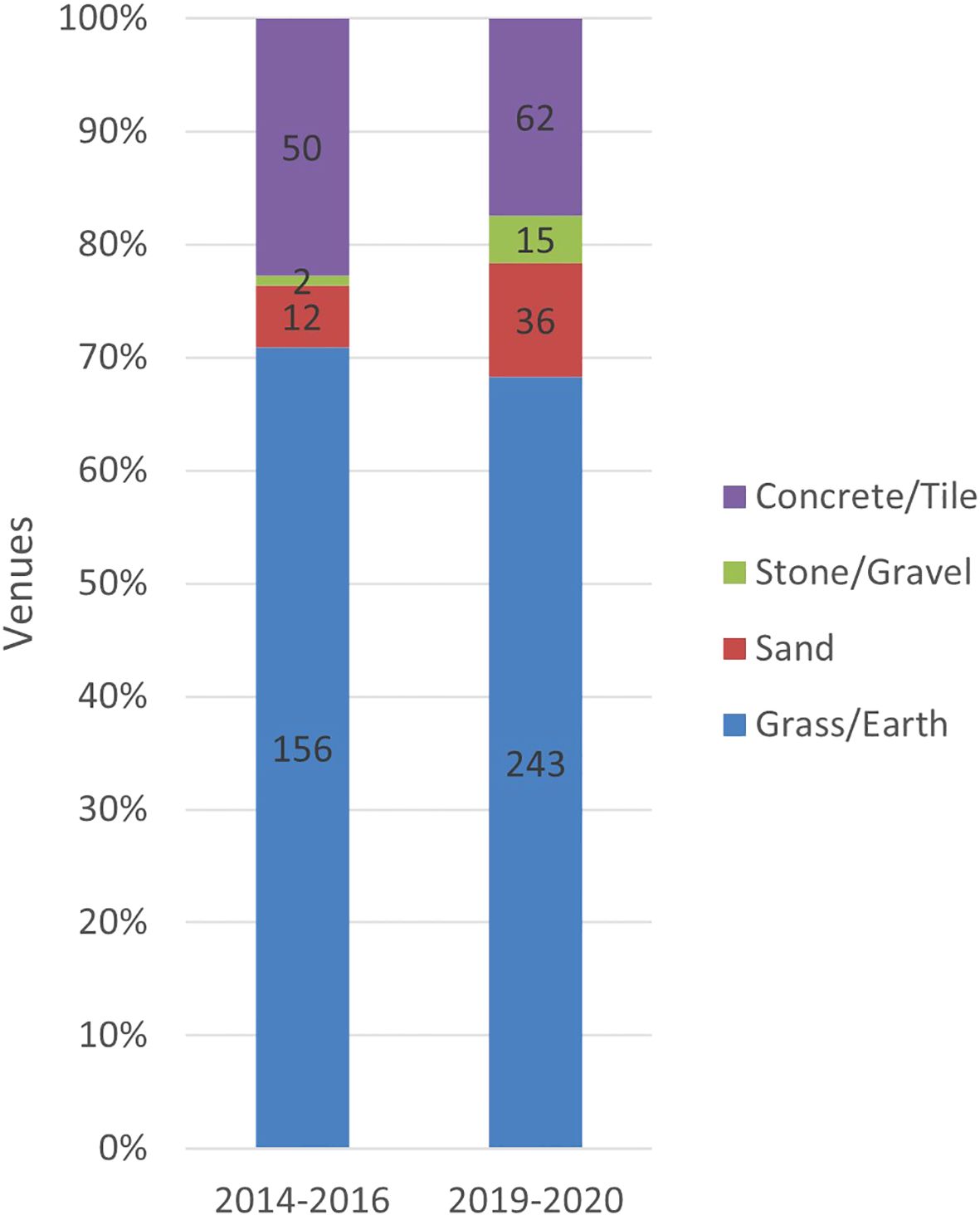
Figure 4. Type of ground substrate available for the majority of elephants, per number and proportion of venues.
Shelter from elements, such as roofed structures, trees, or dense canopy were provided in almost all venues. 56.16% (n=123, 2014-2016, Supplementary Table 5) and 59.83% (n=210, 2019-2020) of venues provided options for full shelter from elements if required. 39.74% (n=87, 2014-2016) and 34.47% (n=121, 2019-2020) of venues provided partial shelter, such as single trees or structures with mesh nets as roof. 4.11% (n=9, 2014-2016) and 5.7% (n=20) of venues provided no shelter to their elephants.
Environmental noise, as measured in close proximity to the elephants’ standing grounds were found to be on average 61dB (n=284, 2019-2020, Supplementary Table 5). At venues where elephant shows were offered, noise levels during those shows were higher at 84dB (n=24, 2019-2020).
Food was provided to elephants reportedly most commonly twice daily (43.84% of venues in 2014-2016 (n=219); 44.54% of venues in 2019-2020 (n=357), Figure 5). Only 8.68% of venues in 2014–2016 enabled freely available food to their elephants. This category saw the largest increase in 2019–2020 with 19.05% of elephants being able to access food freely, e.g. through foraging. It must be noted that the information about the frequency of food provision was only able to be collected from 71.69% (2014-2016) and 79.55% (2019-2020) of visited venues.
Drinking water was observed to be always available at 8.64% of venues (n=19, 2014-2016, Supplementary Table 3) and 19.05% of venues (n=68, 2019-2020) indicating significant improvements in allowing elephants to seek water whenever they desire. The largest proportion of venues reported providing water access through their staff >2 times per day (43.64%, n=96, 2014-2016; 44.54%, n=159, 2019-2020), followed by 19.09% (n=42, 2014-2016) and 15.97% (n=57, 2019-2020) of venues offering water 1–2 times per day.
The vast majority of venues reported allowing their elephants access to water for hygiene measures at least once a day, either through a water hose/bucket, through a supervised bath in a pond or river or even a bath on the elephant’s own terms. However, the latter option of bathing opportunities under the elephants’ own terms were rarest, with 10.91% (n=24, 2014-2016, Supplementary Table 6) and 17.09% (n=61, 2019-2020) of venues offering this. Even rarer were additional hygiene and behavioral enriching opportunities such as mud baths (9.09%, n=20, 2014-2016; 28.85%, n=103, 2019-2020) or sand pits (5%, n=11, 2014-2016; 12.61%, n=45, 2019-2020) even though these opportunities saw the strongest increase in proportion between the two study time frames.
Environmental hygiene in the immediate vicinity of the elephants standing grounds was most commonly impacted through presence of more than 1 day old feces (35.91% of venues, n=79, 2014-2016; 37.54%, n=134, 2019-2020, Supplementary Table 6, as defined as S2–4 of dung survey classification by CITES MIKE or S1 with indication of loss of moisture, color, shape (Hedges and Lawson, 2006)), followed by moist/wet ground (18.18% of venues, n=40, 2014-2016; 27.17%, n=97, 2019-2020), noticeable urine stench (20.45% of venues, n=45, 2014-2016; 13.17%, n=47, 2019-2020), and garbage (8.18%, n=18, 2014-2016; 16.81%, n=60, 2019-2020). Presence of garbage was concluded through presence of a single non-natural waste product, such as plastic bags, wrappings, litter, etc.
3.4 Elephant behavior and entertainment
The primary purpose of elephant tourism venues is to provide experiences to paying visitors. Elephant venues usually offer a range of experience options to visitors. E.g. most venues that offer elephant rides also offer some sort of feeding/selfie activity for a much lower price, while venues that offer washing of elephants often choosing between half-day and full-day programs. In 2014-2016, 77.27% of venues offered elephant riding (n=170, Supplementary Table 7, Figure 6). In 2019-2020, the number of venues offering elephant rides decreased proportionally but increased in absolute numbers to 56.02% (n=200). The second most common tourism activity (excluding feeding, which is often an extra option rather than the primary activity) was washing of elephants, offered by 38.64% (n=85, 2014-2016) and 52.94% (n=189, 2019-2020) of venues. Shows were offered by 17.27% (n=38, 2014-2016) and 12.89% (n=46, 2019-2020). Only 4.55% (n=10, 2014-2016) and 7.84% (n=28, 2019-2020) offered observation-only experiences.
At venues that offered shows, these were most typically offered 2–3 times per day (61.54%, n=24, 2014-2016; 45.65%, n=21, 2019-2020), while a significant increase was observed in venues offering shows >3 times per day (25.64%, n=10, 2014-2016; 39.13%, n=18, 2019-2020).
Specific to the riding activity, several aspects that may impact the elephants’ welfare were explored in more detail (Supplementary Table 8). In 2019-2020, this study found that the offered ride durations generally decreased. 11.5% of venues (n=23) even offered rides of less than 15min duration, which was not found in 2014-2016. The majority of offered rides were between 15-60min, with a handful of venues (6.47%, n=11, 2014-2016; 3%, n=6, 2019-2020) offering rides longer than 2 hours. Most commonly, rides would be conducted with steel saddles (71.76%, n=122, 2014-2016; 59%, n=118, 2019-2020), using a coated saddle rope and with a maximum of 2 passengers. However, at 24.12% (n=41, 2014-2016) and 27.5% (n=55, 2019-2020) of venues more than 2 passengers were seen riding on the elephant.
3.5 Animal welfare condition scores
The averaged scores for the selected categories that were considered to be of relevance to animal welfare mostly ranged in the lower half up to the middle of the scoring scale (Figure 7, Supplementary Table 9). In both study periods, scores for ‘Mobility’ came in lowest, indicating short comings in the ability of elephants to move around autonomously, followed by ‘Entertainment Intensity’, reflecting the common practices of elephant riding or shows at a large number of venues. Across almost all categories the scores improved between the two study periods, with mobility showing the proportionally largest improvements, but continuing to rank lowest across the categories. The averaged scores for Daytime rest area, Hygiene and Naturalness showed the highest scores at 2.22, 2.18, and 2.14 respectively in 2019-2020.
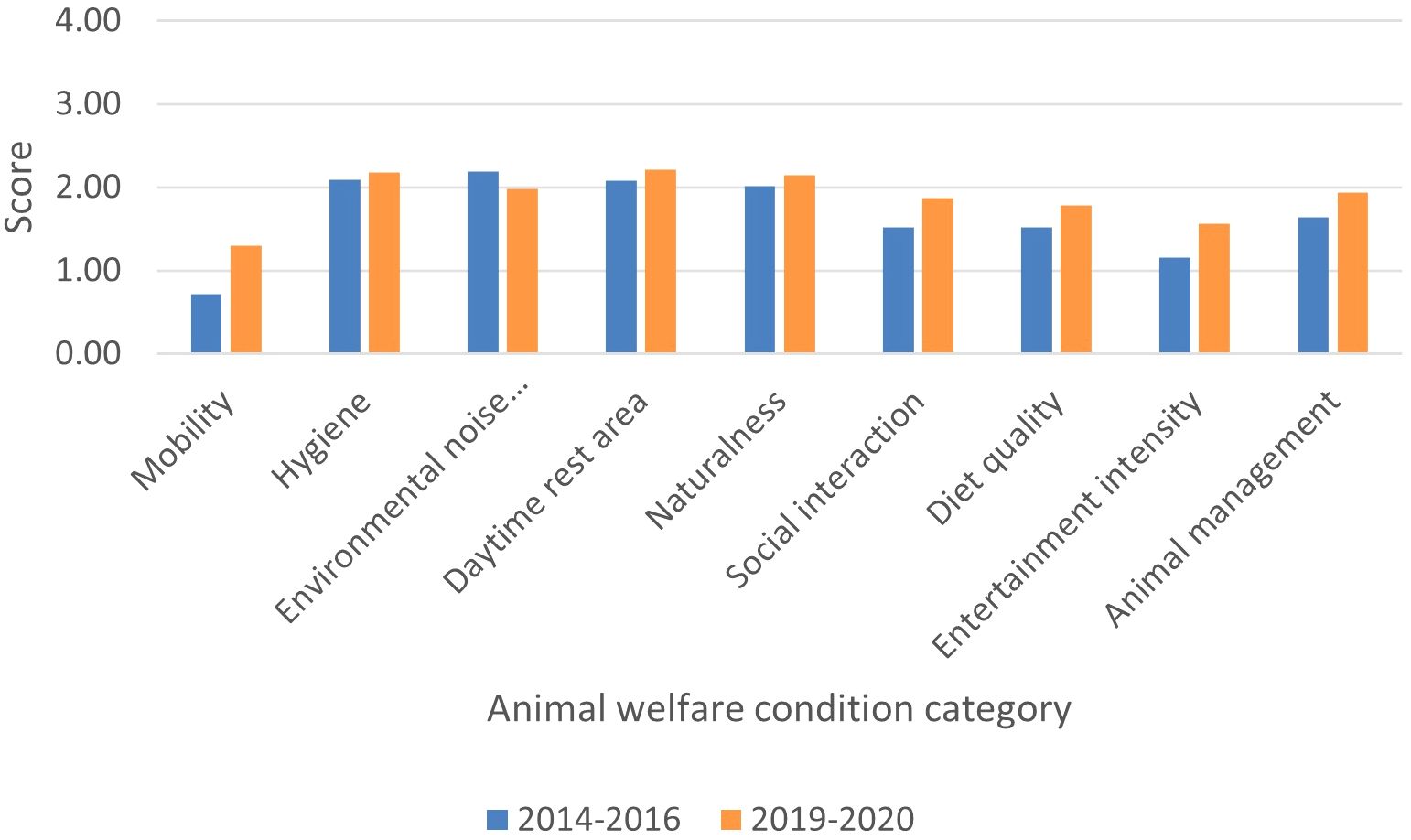
Figure 7. Average animal welfare condition scores by category for all captive elephant venues (n=220, 2014-2016; n=357, 2019-2020.
Converting the individual category scores into a single animal welfare condition score between 1 and 10 for each venue allows for further insights when combined with demographic data points. Calculating the total number of elephants housed at venues with similar scores, shows peaks at scores 3 in 2014–2016 and 4 in 2019-2020, followed by a gradual decrease towards the higher scores. In 2014-2016 76.6% and in 2019-2020 63.3% of elephants were housed at venues scoring 5 or less (Figure 8).
We also observed an apparent correlation between the animal welfare condition scores and the percentage of displayed stereotypies of all observed elephants not participating in tourism activities. This correlation is particularly obvious when the data is grouped in three score groups (Scores 2-4: 25% of elephants displayed stereotypies; Scores 5-7: 20.4%; Scores 8-10: 4.1%) (Figure 9).
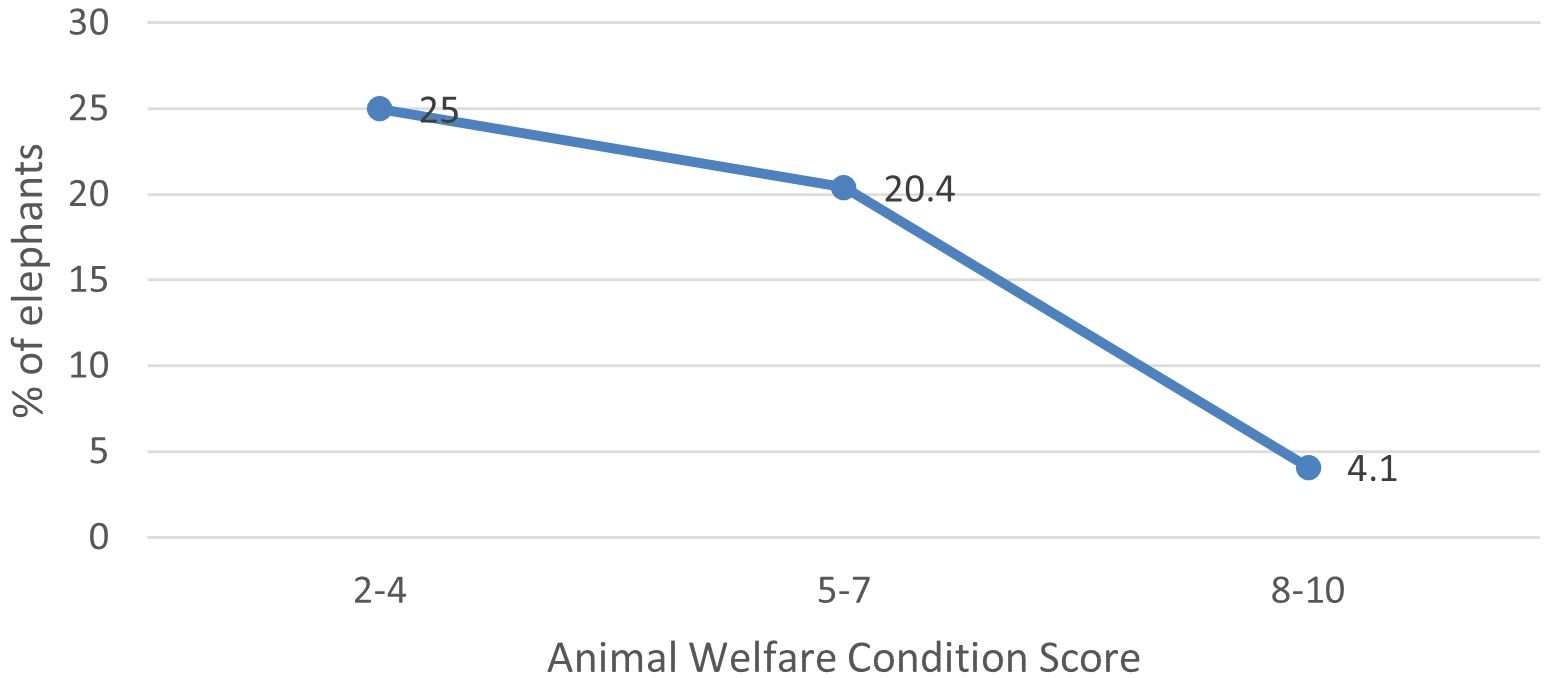
Figure 9. Percentage of stereotypies in all observed, non-active elephants grouped by Animal Welfare Condition Score group.
Breaking the scores down by country reveals differences in the average scores on country level (Figure 10).
Displaying the combined scores of elephant venues contained within the defined grid cells and overlayed over each country’s geography, shows distinctive clusters of elephant venues near tourism hot spots (Figures 11A-C). This analysis is less insightful for countries with only a few venues across large country sizes, but it does give interesting results for Thailand with its large number of elephant venues. Here, distinctive clusters of elephant venues can be found in the northern region around Chiang Mai, along a belt in the central region from Kanchanaburi over Bangkok to Pattaya, and in the southern region around Phuket. Across the two study periods, the size of those clusters increases, reflecting a wider spread of venues. Interestingly, when color coding the cells by average animal welfare condition scores of the contained venues, it is apparent that venues in the north of Thailand received significantly higher scores than venues in the central and southern region of Thailand. Particularly around the Bangkok area several cells show very low average scores, representing a concentration of venues with low welfare condition scores.
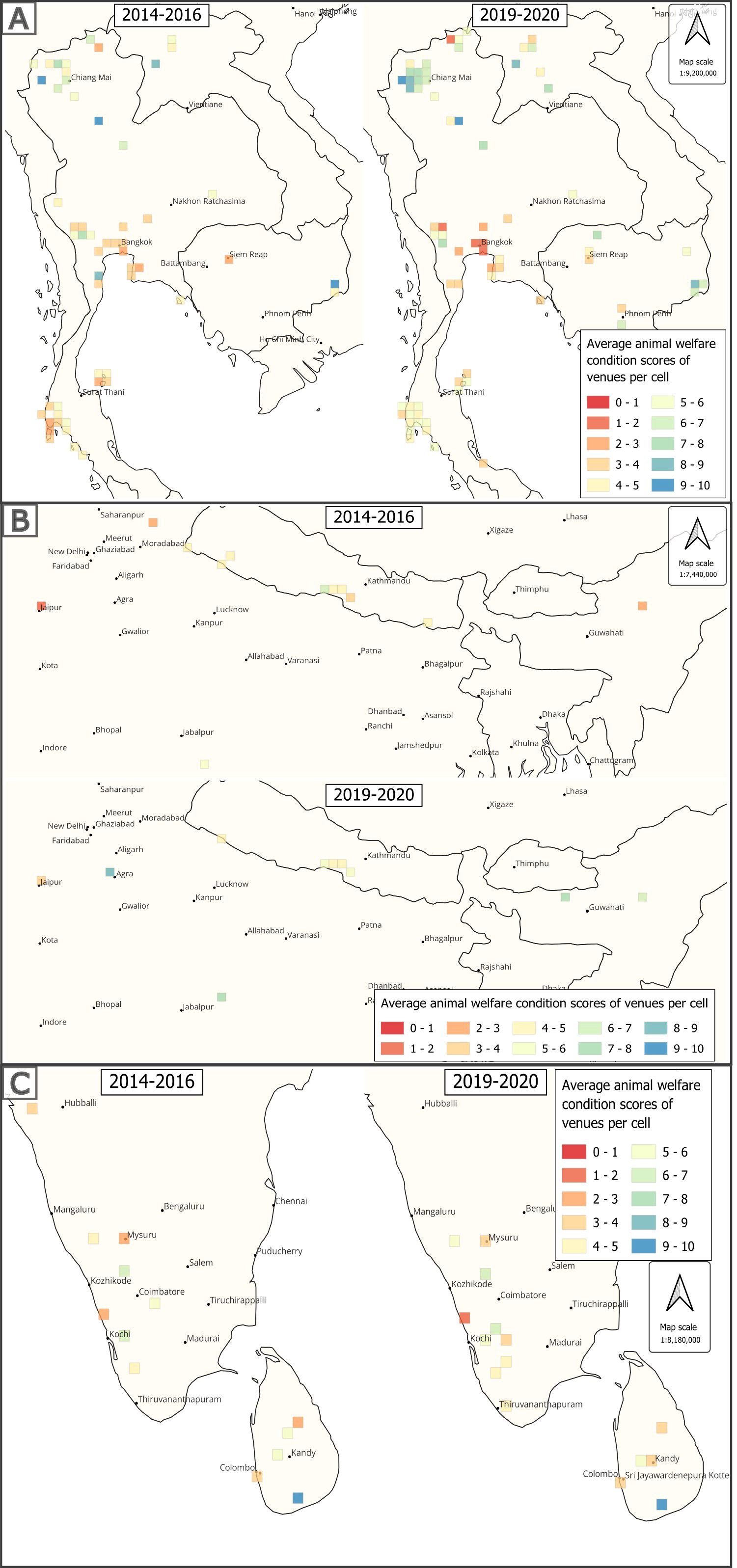
Figure 11. (A-C) Average animal welfare condition scores of all venues within a grid cell in 2014–2016 and 2019–2020 for Thailand, Laos and Cambodia (A), northern India and Nepal (B), and southern India and Sri Lanka (C).
4 Discussion
As of January 2020, 3,837 elephants were kept at 357 tourism venues across Thailand, India, Nepal, Sri Lanka, Laos, Cambodia and Malaysia. Nearly three quarters (73%) of these elephants were based in Thailand, where there are more than twice the number of elephant venues than the other countries combined. Across all countries elephants were kept for tourism experiences including rides (offered at 57% of venues), circus-style shows (offered at 32% of venues), washing and bathing (offered at 53% of venues) and feeding interactions (offered at 72% of venues). A further 5% of venues allowed tourists to observe the elephants with no interactive elements. Evaluating the conditions provided for the elephants and quantifying the tourism activities they were offered for enabled us to identify key areas of welfare concern across the industry.
4.1 Industry trends in Thailand 2010 – 2020
This data presented, complemented by the authors’ earlier study in Thailand from 2010, shows that Thailand is the epicenter of captive elephant tourism, and that the industry has experienced exponential growth in recent decades. Between 2010 and 2020, the number of elephant venues across the country more than doubled, growing by 134%. The number of elephants held at these venues also grew, increasing by 30% from 1,688 elephants in 2010 to 2,198 in 2015, and a further 27% increase from 2,198 to 2,765 elephants between 2015 and 2020. This results in a 70% increase in the total number of captive elephants at tourism venues across Thailand over the decade. Our data also shows the average number of calves born per year across captive venues rose from 30 per year in 2015 to 50 per year in 2020, indicating the growth trajectory of the industry was continuing up until the COVID-19 pandemic. More data are needed to ascertain the effect of the pandemic on the current industry growth.
Most of the increase in the industry occurred in the group of venues scoring 6–8 in the assessment. These venues represent 43% of all venues in Thailand and house 25% of all tourism elephants, compared to just 14% of elephants in 2015 and 9% in 2010. They are typically small to moderately sized venues, offering washing and bathing or ‘Be a mahout’ tourism activities. These types of attractions have increased substantially in the past five years, more than tripling in numbers from 50 venues in 2015 to 161 venues in 2020. New camps are increasingly offering these experiences perceived as passive options and have less reliance on typical activities like riding (Bansiddhi et al., 2018; Brown et al., 2020). This may be to cater to an increasing demand for experiences and attractions deemed “sustainable”, “eco” and “ethical”, particularly from western tourists (Todd, 2012; Von Essen et al., 2020; Winter, 2020), which may partially explain the observed increase in the number of venues using elephant enclosures in place of other restraining methods such as chaining. However, as noted earlier in this article, elephants used for this type of activity still face a multitude of welfare challenges. Many of these venues label themselves as ‘sanctuaries’ or ‘rescue centers’ despite continuing to breed elephants for commercial purposes and offering conventional commercial elephant tourism activities. Captive elephant tourism in Thailand generates between $581.3 million to $770.6 million US dollars annually, with approximately 45% of this coming from washing and bathing activities (Schmidt-Burbach and Hartley-Backhouse, 2020). The 25.8% increase in tourism elephant numbers over the five years between our two assessment periods broadly correlates with the increase in international tourism arrivals to the country over a comparable timeframe (33% increase 2015 – 2019) (Thailand Ministry of Tourism & Sports, Tourism Statistics, 2020). Further research is needed to quantify the effect that loss of income resulting from the COVID-19 pandemic and subsequent associated changes to tourism in Thailand has had on the elephant industry since 2020.
4.2 Welfare concerns
In 2019-2020, sixty three percent (63%) of all elephants assessed were kept at venues scoring between 1 and 5, which is the lower half of the range on our score scale. A further 30% were in venues that scores between 6 and 8 points. This means 93% of elephants assessed were subject to at least some substantial welfare concerns. Given that these data reflect the most broad and comprehensive study on conditions for captive tourism elephants across Asia to date, the potential welfare concerns highlighted in these results have implications on a wide scale for thousands of elephants across the industry.
Welfare challenges for captive elephants in tourism documented in the literature include poor body condition, injuries from mismanagement, foot sores and nail cracks from excessive walking on inappropriate substrate, stress associated with being too close to tourists or from being chained and separated from conspecifics, and a lack of veterinary oversight despite a wealth of physical conditions such as parasites, colic and eye infections (Vanitha et al., 2010; Norkaew et al., 2019; Bansiddhi et al., 2020). We did not document individual elephant well-being using behavioral or physical health indicators, but our data did capture that 15% of elephants observed exhibited stereotypies, a potential indication of experiencing stress.
Further welfare challenges have also been documented for elephants wearing a saddle (howdah) for carrying tourists on rides. The howdah can lead to abrasions, abscesses and rope burns resulting from the platform strapped to their back (Varma and Ganguly, 2011; Magda et al., 2015; Szydlowski, 2022). The intensity of work (particularly longer working days and the provision of breaks) have been identified as a risk factor for elephants having active lesions resulting from saddle related equipment (Magda et al., 2015; Bansiddhi et al., 2020). While new, improved saddle equipment can reduce wounds and injuries (Brown et al., 2020), our data show that in 2020 over 2,000 elephants still had wooden or steel saddles at venues offering saddled rides to tourists every day, particularly in Laos, where 83% of riding venues used saddles, and Nepal, where 100% used saddles.
A suggested benefit of elephant rides is the idea that it enables elephants to get regular exercise throughout the day which can improve their health (Norkaew et al., 2019; Brown et al., 2020) but this may not be as beneficial as it is sometimes regarded. Data show that for Asian elephants walking may be a largely appetitive behavior, expressed as a means to secure resources (e.g. foraging for nutrition or to seek social or physical contact), not a behavior that is expressed for its own sake (Veasey, 2020). Thus monotonous or repetitive walking circuits under the control of a mahout at tourism venues may not necessarily provide any substantive well-being value for the elephants. In these circumstances elephants are also typically dependent on tourist demand for any walking activity to occur, otherwise they remain chained for long periods of the day, which has the opposite effect in severely restricting opportunity for movement and exercise. For most of the elephants at venues scored at the lowest end of the scale in our assessment, chaining is a common feature during both day and night when not used in activities, meaning 63% of all elephants across the industry may not get adequate opportunity for movement.
Chaining is also common in venues represented by scores 6–8, documented for 30% of elephants in 2020. These venues typically provided a more natural environment, less intensive tourist activities, fewer working hours, and no saddled riding attractions. However, most of the elephants were kept on chains between 5-15m when not engaged in a tourist activity. This severely limits their opportunity for social interaction with conspecifics and for foraging.
While in both research periods short chains were the dominant restraint form, the data suggests a tendency towards allowing greater freedom of movement under restraint as indicated by the proportional decrease of venues resorting to short chains and the increase in venues using longer chains, enclosures or supervised free range during the day.
Elephants’ psychosocial functioning dictates that most of their natural time is spent in large social groups, foraging for food (Curtin et al., 2021). Provisioning for these social behaviors in captivity has been identified as a priority for protecting the psychological needs of captive elephants and is considered among the most important welfare priorities for this species (Veasey, 2020). Our data show that 97% of tourism venues offer interactive feeding experiences, where visitors can pay to hand feed elephants. While this hand feeding does not necessarily impact the elephant’s nutrient intake, it does deprive them of the opportunity to browse and forage for their own food, a process which affords social interaction, information gathering and processing, collective and individual decision making and locomotion (Veasey, 2020). It also limits their eating period to short intervals throughout the day, in contrast to their pattern of steady foraging throughout the day in the wild (Szydlowski, 2022). Allowing elephants to forage enables them to express appropriate motivated behaviors and cognitive processes, rather than have direct provisioning dictated by humans, which may be beneficial for their welfare (Veasey, 2020).
Furthermore, the direct and unprotected contact between visitors and elephants in these venues scoring 6–8 does not alleviate the need for conventional, coercive training as visitor safety dictates to be able to fully control elephants at all times. Commonly, this training includes a separation of mother and calf, which previous investigations have shown to typically occur at just two years old (Schmidt-Burbach and Hartley-Backhouse, 2020). This is in stark contrast to the wild where females tend to stay within their herd indefinitely and males only leave around the age of 10–15 years old (Vidya and Sukumar, 2005). After the training process, handlers must still assert control of elephants, particularly around tourists. Although elephant management in many zoo settings is gradually changing, moving progressively towards a more “hands-off”, protected contact approach to minimize human induced stress (Crawley et al., 2019), the use of ankhus to express and reinforce the dominance of the mahouts over the elephants to ensure tourist and mahout safety is still widespread (Bansiddhi et al., 2019a; Brown et al., 2020). One study showed around 27% of elephants controlled by an ankhus exhibited wounds in the areas where the ankhus is predominantly used (Bansiddhi et al., 2019a).
Our results show that in 2019-2020, 7% of all elephants assessed were kept at venues where conditions can be described as ‘best possible under captive management’, receiving scores of 9 or 10 in our assessment criteria. These venues typically provide elephants chain-free access to enclosures or natural habitat throughout the day, free ability for social interactions on their own terms, opportunity to browse and forage in natural habitat with varied terrain, no exposure to large crowds or loud noises (such as venue music or busy roads) and very limited or no interaction with people. These conditions, alongside other integral foundations for welfare such as adequate veterinary attention and balanced nutrition, can be considered as best possible practice for elephant care under captive conditions. However, it is inevitable that all types of captivity inhibit some natural behaviors and remove a wild animal’s autonomy to some extent. For example, in captive populations the formation of social groups are artificially selected within the confines of the group, in contrast to free-ranging wild populations where herds form multi-generational matrilineal groups in which bulls can periodically join and leave (Glaeser et al., 2021). Similarly, the opportunity for movement in captivity is limited to the size of the facility, in contrast to wild populations that can cover between 5-10km daily (Brady et al., 2021) and have home ranges home between 30km² to 600km² (IUCN Asian Elephant Specialist Group, [[NoYear]]).
The COVID-19 pandemic also brought a new set of challenges for all people and elephants in the captive elephant tourism industry, irrespective of their venue conditions. Mahouts and elephant owners faced income loss, worsened conditions from housing and husbandry issues, and food shortages, leading to a reliance on NGOs and grassroots organizations, community members, and governmental agencies to retain ownership of elephants (Schmidt-Burbach and Hartley-Backhouse, 2020; Szydlowski, 2022). Some owners resorted to selling their elephants, laying off mahouts and leaving the industry altogether (Szydlowski, 2022). During this period many elephants also experienced higher levels of social isolation from being stabled or having to leave elephant venues to return to the mahout’s home village, which disconnected them from any tactile, olfactory, or visual contact with conspecifics, further reducing their welfare (Schmidt-Burbach and Hartley-Backhouse, 2020; Szydlowski, 2022). The pandemic highlighted the vulnerability and dependency of captive elephants on tourism income for their survival, demonstrating how keeping wild animals at the whim of a commercial industry can leave them vulnerable to uncontrollable variables like economic fluctuations. Other external factors have been noted to disrupt the viability of the industry, including seasonal variation in tourism as a result of weather conditions, as well as political turmoil and natural disasters (Szydlowski, 2022).
4.3 Limitations
As well as being limited to pre-pandemic data, our study is limited to rapid assessments of overall conditions provided at elephant venues. Evaluating the conditions that affect elephants’ welfare daily enabled us to identify key areas of welfare concern across the industry and to conduct assessments on a large scale, but assessing welfare at an individual level using direct measures would allow for a more comprehensive understanding of the industry’s impact on elephant’s well-being. However, this would require long-term monitoring of behavioral and physical health parameters which would be difficult to implement on a large scale and would be resource intensive. There is also no gold standard for measuring elephant welfare. Commonly used measures of stress, such as glucocorticoid output and stereotypic behavior are not reliable indicators when used in isolation; there are many confounding factors which need to be taken into consideration that are often complex to identify, distinguish and monitor in non-controlled environments (Millspaugh and Washburn, 2004; Palme, 2019). It is generally accepted that a multi-method, integrated approach is the most effective way to measure animal welfare (Brando and Buchanan-Smith, 2018; Wolfensohn et al., 2018). Bansiddhi et al. (2020) proposed a range of additional health parameters to be developed and validated as objective indices to assess the welfare of Asian elephants under human care (Bansiddhi et al., 2020). We suggest that assessments also integrate more expansive concepts such as the Quality-of-Life index, the Five Domains of Animal Welfare model, and the Extended Welfare Assessment Grid for an overall assessment of each elephant’s cumulative experience, including both acute and chronic stress exposure over time, and the subsequent implications for individual well-being. We hope that our approach to evaluate living conditions on a large scale across the industry can contribute to the wider understanding of captive elephant welfare by providing a broader perspective of the conditions that affect the animal’s experience daily.
4.4 Conclusions and recommendations
Our data indicate that despite fluctuating trends and some improvements in management, conditions for captive elephants at entertainment venues across Asia are still largely inadequate across the board. Over 3,000 elephants bred and kept in captivity for tourism face significant challenges to their welfare. While the type and severity of these welfare challenges varies considerably, all types of commercial captive use inhibit natural behavior and constrain a wild animal’s autonomy to some extent. Additionally, all types of unprotected contact with elephants require intensive training and subsequent dominance by elephant handlers to ensure tourist safety. Despite perceived improvements in the types of tourism activities offered to tourists, particularly in Thailand, the reality is that those changes are a diversification of business ventures to cater to an emerging demand for more ethical tourism experiences, but still generate many of the same welfare challenges as the original riding and performance activities. The captive elephant tourism industry was experiencing overall growth up to 2020 and further assessments are needed to quantify the state of the industry following the effects of the COVID-19 pandemic. We recommend that future assessments of animal welfare for elephants in this industry encompass a broader perspective than the current popular approach of small scale, short term, acute measures of stress, which are likely not reflective of the elephants’ welfare on the whole.
Data availability statement
The original contributions presented in the study are included in the article/Supplementary Material. Further inquiries can be directed to the corresponding author.
Author contributions
JG: Investigation, Project administration, Writing – original draft, Writing – review & editing. JS-B: Conceptualization, Data curation, Formal analysis, Investigation, Methodology, Supervision, Writing – review & editing. LH-B: Writing – review & editing, Data curation, Methodology, Supervision, Conceptualization, Project administration, Validation, Investigation.
Funding
The author(s) declare that no financial support was received for the research and/or publication of this article.
Conflict of interest
The authors declare that the research was conducted in the absence of any commercial or financial relationships that could be construed as a potential conflict of interest.
Generative AI statement
The author(s) declare that no Generative AI was used in the creation of this manuscript.
Publisher’s note
All claims expressed in this article are solely those of the authors and do not necessarily represent those of their affiliated organizations, or those of the publisher, the editors and the reviewers. Any product that may be evaluated in this article, or claim that may be made by its manufacturer, is not guaranteed or endorsed by the publisher.
Supplementary material
The Supplementary Material for this article can be found online at: https://www.frontiersin.org/articles/10.3389/fetho.2025.1532995/full#supplementary-material
References
Alves R. R. N. (2016). Domestication of animals. Introduction to Ethnobiology, 221–225. doi: 10.1007/978-3-319-28155-1_32
Baker L. and Winkler R. (2020). Asian elephant rescue, rehabilitation and rewilding. Anim. Sentience. 296, 20. doi: 10.51291/2377-7478.1506
Bansiddhi P., Brown J. L., Khonmee J., Norkaew T., Nganvongpanit K., Punyapornwithaya V., et al. (2019a). Management factors affecting adrenal glucocorticoid activity of tourist camp elephants in Thailand and implications for elephant welfare. PloS One 14. doi: 10.1371/journal.pone.0221537
Bansiddhi P., Brown J. L., Thitaram C., Punyapornwithaya V., and Nganvongpanit K. (2020). Elephant tourism in Thailand: A review of animal welfare practices and needs. J. Appl. Anim. Welfare Science. 23, 164–177. doi: 10.1080/10888705.2019.1569522
Bansiddhi P., Brown J. L., Thitaram C., Punyapornwithaya V., Somgird C., Edwards K. L., et al. (2018). Changing trends in elephant camp management in northern Thailand and implications for welfare. PeerJ. 6, p.e5996. doi: 10.7717/peerj.5996
Bansiddhi P., Nganvongpanit K., Brown J. L., Punyapornwithaya V., Pongsopawijit P., and Thitaram C. (2019b). Management factors affecting physical health and welfare of tourist camp elephants in Thailand. PeerJ 7. doi: 10.7717/peerj.6756
Brady A., McMahon B. J., and Naulty F. (2021). Estimates of locomotion in Asian elephants Elephas maximus using video monitoring at Dublin Zoo, Ireland. J. Zoo Aquarium Res. 9, 124–133. doi: 10.19227/jzar.v9i2.502
Brando S. and Buchanan-Smith H. M. (2018). The 24/7 approach to promoting optimal welfare for captive wild animals. Behav. processes. 156, 83–95. doi: 10.1016/j.beproc.2017.09.010
Brown J. L., Bansiddhi P., Khonmee J., and Thitaram C. (2020). Commonalities in management and husbandry factors important for health and welfare of captive elephants in North America and Thailand. Animals 10, 737. doi: 10.3390/ani10040737
Carder G., Proctor H., Schmidt-Burbach J., and D’cruze N. (2016). The animal welfare implications of civet coffee tourism in Bali. Anim. Welfare 25, 199–205. doi: 10.7120/09627286.25.2.199
Crawley J. A., Lahdenperä M., Seltmann M. W., Htut W., Aung H. H., Nyein K., et al. (2019). Investigating changes within the handling system of the largest semi-captive population of Asian elephants. PloS One 14. doi: 10.1371/journal.pone.0209701
Cruise A. (2017). Dozens of Laotian elephants ‘illegally sold to Chinese zoos’ (The Guardian). Available at: https://www.theguardian.com/environment/2017/jul/25/dozens-of-laotian-elephants-illegally-sold-to-chinese-zoos (Accessed August 6, 2025).
Curtin S., Day C., Laws E., Scott N., Font X., and Koldowski J. (Eds.) (2021). “Alternative forms of elephant tourism,” in The elephant tourism business, 1st ed (CABI, UK), 73–84. doi: 10.1079/9781789245868.0006
Dalton J. (2018). Illegal trafficking of baby elephants to China and Dubai for tourism must be stopped, say activists (The Independent). Available at: https://www.independent.co.uk/climate-change/news/elephants-Laos-China-dubai-trafficking-illegal-cites-tourist-trip-cites-stae-a8517431.html (Accessed June 9, 2025).
Elephant Specialist Alliance International (2021). Statement on Exhibition of Elephants in Captivity. Available online at: https://elephant-specialists.org/wp-content/uploads/2021/03/ESAI_Statement-on-Exhibition-of-Elephants-in-Captivity-2.pdf (Accessed June 9, 2025).
Glaeser S. S., Shepherdson D., Lewis K., Prado N., Brown J. L., Lee B., et al. (2021). Supporting zoo Asian elephant (Elephas maximus) welfare and herd dynamics with a more complex and expanded habitat. Animals 11. doi: 10.3390/ani11092566
Hankinson E. and Nijman V. (2020). “Asian Elephants: 15 years of research and conservation,” in Journal of Physics: Conference Series. 1460 (1), 012055. doi: 10.1088/1742-6596/1460/1/012055
Hedges S. and Lawson D. (2006). Dung Survey Standards for the MIKE Programme (CITES MIKE). Available at: https://cites.org/sites/default/files/common/prog/mike/survey/dung_standards.pdf.
IUCN Asian Elephant Specialist Group Elephas maximus, Asian Elephant IUCN Red List of Threatened Species 2020 Assessment. Available online at: https://www.asesg.org/PDFfiles/Asian%20Elephant%20Red%20List%20Assessment%202020.pdf (Accessed June 9, 2025).
IUCN Asian Elephant Specialist Group (2018). The Asian Elephants (Elephas maximus) (IUCN). Available at: https://www.asesg.org/PDFfiles/The%20Asian%20Elephants%20new.pdf.
Jaysinghe N. and Soe P. (2017). Workshop on addressing human–elephant conflict in Myanmar. Gajah 46, 40–42. Available at: https://www.asesg.org/PDFfiles/2017/Gajah%2046/46-40-WorkshopMyanmar.pdf (Accessed June 9, 2025).
Keerthipriya P. and Vidya T. N. C. (2019). A comparison of the occurrence of musth in the Kabini elephant population with other populations. Gajah 50, 4–16. Available at: https://www.asesg.org/PDFfiles/2019/Gajah-50-All.pdf#page=8 (Accessed June 9, 2025).
Kido N., Tanaka S., Omiya T., Kamite Y., Sawada K., Komatsu Y., et al. (2020). Emotion estimation using a wearable heart rate monitoring device in Asian elephants (Elephas maximus) during veterinary clinical procedures. J. Veterinary Med. Sci. 82 (6), pp.856–860. doi: 10.1292/jvms.19-0637
Kurt F. and Mar K. U. (2003). Guidelines for the management of captive Asian elephants and the possible role of the IUCN/SSC Asian Elephant Specialist Group. Gajah. 22, 22–30. Available at: https://www.asesg.org/PDFfiles/Gajah/22-30-Kurt.pdf (Accessed June 9, 2025).
Magda S., Spohn O., Angkawanish T., Smith D. A., and Pearl D. L. (2015). Risk factors for saddle-related skin lesions on elephants used in the tourism industry in Thailand. BMC Vet Res. 11, 117. doi: 10.1186/s12917-015-0438-1
Millspaugh J. J. and Washburn B. E. (2004). Use of fecal glucocorticoid metabolite measures in conservation biology research: considerations for application and interpretation. Gen. Comp. Endocrinol. 138, 189–199. doi: 10.1016/j.ygcen.2004.07.002
Mumby H. S. (2019). Mahout perspectives on asian elephants and their living conditions. Animals. 9, 879. doi: 10.3390/ani9110879
Nijman V. (2014). An assessment of the live elephant trade in Thailand (Cambridge, UK: TRAFFIC International). Available at: https://www.traffic.org/site/assets/files/8423/elephant-trade-thailand.pdf (Accessed August 6, 2025).
Nokkaew W., Intarapuk A., Sakulthai A., Wajjwalku W., and Thongtip N. (2022). Study of fecal glucocorticoid metabolites in captive Asian elephants in Kanchanaburi Province, Thailand. Veterinary World. 15, 647. doi: 10.14202/vetworld.
Norkaew T., Brown J. L., Thitaram C., Bansiddhi P., Somgird C., Punyapornwithaya V., et al. (2019). Associations among tourist camp management, high and low tourist seasons, and welfare factors in female Asian elephants in Thailand. PloS One 14. doi: 10.1371/journal.pone.0218579
Palme R. (2019). Non-invasive measurement of glucocorticoids: advances and problems. Physiol. Behav. 199, 229–243. doi: 10.1016/j.physbeh.2018.11.021
Rizzolo J. B. and Bradshaw G. A. (2016). Prevalence and patterns of complex PTSD in Asian elephants (Elephas maximus) (Kelaniya, Sri Lanka: Centre for Asian Studies, University of Kelaniya), 291–297.
Rizzolo J. B. and Bradshaw B. (2018). “Human leisure/elephant breakdown – impacts of tourism on Asian elephants,” in Wild Animals and Leisure: Rights and Wellbeing in the Ethics of Tourism Series. Eds. Carr N. and Young J. (Oxfordshire, United Kingdom: Routledge).
Sakamoto M. (2017). Recent topics on CITES related to Asian elephants in particular. Gajah 47, 42–44. Available at: https://www.asesg.org/PDFfiles/2017/Gajah%2047/47-42-CITES.pdf (Accessed June 9, 2025).
Schmidt-Burbach J. (2017). Taken for a ride: The conditions for elephants used in tourism in Asia. World Anim. Protection.
Schmidt-Burbach J. and Hartley-Backhouse L. (2020). Elephants. Not commodities. Taken for a ride 2 (World Animal Protection). Available online at: https://www.worldanimalprotection.org/globalassets/pdfs/reports/english/elephants-not-commodities-taken-for-a-ride-2.pdf (Accessed July 13, 2025).
Schmidt-Burbach J., Ronfot D., and Srisangiam R. (2015). Asian elephant (Elephas maximus), pig-tailed macaque (Macaca nemestrina) and tiger (Panthera tigris) populations at tourism venues in Thailand and aspects of their welfare. PloS One 10. doi: 10.1371/journal.pone.0139092
Sukumar R. (2003). The living elephants: evolutionary ecology, behaviour, and conservation (Oxford, United Kingdom: Oxford University Press).
Szydlowski M. (2022). Elephants in Nepal: Correlating disease, tourism, and welfare. J. Appl. Anim. Welfare Sci., 1–13. doi: 10.1080/10888705.2022.2028628
Thailand Ministry of Tourism & Sports, Tourism Statistics. (2020). Thailand Ministry of Tourism & Sports, Tourism Statistics. Thailand.
Todd C. S. (2012). “The importance of the aesthetic,” in The Routledge handbook of tourism and the environment (Routledge), 65–74. Available at: https://www.taylorfrancis.com/chapters/edit/10.4324/9780203121108-8/importance-aesthetic-cain-todd.
Vanitha V., Thiyagesan K., and Baskaran N. (2010). Daily routine of captive Asian elephants (Elephas maximus) in three management systems of Tamil Nadu, India and its implications for elephant welfare. J. Sci. Trans. Environ. Technov 3, 116–122. doi: 10.20894/STET.116.003.003.002
Varma S. and Ganguly S. (2011). Captive Elephants in Bardia National Park, Nepal: Investigations Into the Population, Management, Welfare and a Review of Elephant Training by Working Elephant Programme of Asia (WEPA), and WWF Finland at Bardia Hattisar (Compassion Unlimited Plus Action (CUPA) in collaboration with Asian Nature).
Veasey J. S. (2020). Assessing the psychological priorities for optimising captive asian elephant (Elephas maximus) welfare. Animals 10, 39. doi: 10.3390/ani10010039
Vidya T. N. C. and Sukumar R. (2005). Social and reproductive behaviour in elephants. Curr. Sci., 1200–1207.
Vijayakrishnan S. and Sinha A. (2019). Human-captive elephant relationships in kerala: historical perspectives and current scenarios. Gajah 50, 29–35. Available at: https://www.cabidigitallibrary.org/doi/full/10.5555/20203172293 (Accessed June 9, 2025).
Von Essen E., Lindsjö J., and Berg C. (2020). Instagranimal: Animal welfare and animal ethics challenges of animal-based tourism. Animals 10, 1830. doi: 10.3390/ani10101830
Winter C. (2020). A review of animal ethics in tourism: Launching the annals of tourism research curated collection on animal ethics in tourism. Ann. Tourism Res. 84. doi: 10.1016/j.annals.2020.102989
Wolfensohn S., Shotton J., Bowley H., Davies S., Thompson S., and Justice W. S. (2018). Assessment of welfare in zoo animals: Towards optimum quality of life. Animals. 8, 110. doi: 10.3390/ani8070110
Keywords: Asian elephant, Elephas maximus, captivity, welfare, tourism
Citation: Green J, Schmidt-Burbach J and Hartley-Backhouse L (2025) Giants in tourism: captive conditions, industry trends, and animal welfare implications for Asian elephants in tourism from 2014 to 2020. Front. Ethol. 4:1532995. doi: 10.3389/fetho.2025.1532995
Received: 22 November 2024; Accepted: 19 May 2025;
Published: 02 July 2025.
Edited by:
Jesús A. Rivas, New Mexico Highlands University, United StatesReviewed by:
Heather M. Hill, St. Mary’s University, United StatesKelly S. Bricker, Arizona State University, United States
Rebecca Winkler, University of Pennsylvania, United States
Copyright © 2025 Green, Schmidt-Burbach and Hartley-Backhouse. This is an open-access article distributed under the terms of the Creative Commons Attribution License (CC BY). The use, distribution or reproduction in other forums is permitted, provided the original author(s) and the copyright owner(s) are credited and that the original publication in this journal is cited, in accordance with accepted academic practice. No use, distribution or reproduction is permitted which does not comply with these terms.
*Correspondence: Jennah Green, SmVubmFoLkdyZWVuQFJTUENBLm9yZy51aw==
 Jennah Green
Jennah Green Jan Schmidt-Burbach
Jan Schmidt-Burbach Lindsay Hartley-Backhouse
Lindsay Hartley-Backhouse